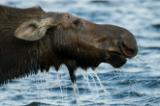 © Pete Saloutos/Panoramic Images (Maine Title Image Large)
© Pete Saloutos/Panoramic Images (Maine Title Image Large)

Maine Wildlife Action Plan
By the Association of Fish and Wildlife Agencies
Maine’s Wildlife Action Plan addresses the full array of fish and wildlife and their habitats across the state, including vertebrates and invertebrates. The plan targets species in greatest need of conservation while seeking to keep “common species common.” The plan covers the entire state, from the coastline to the heights of Mt. Katahdin. It is intended to supplement, not duplicate, existing fish and wildlife programs, and it builds on a species planning effort that has been ongoing for nearly 40 years, a landscape approach to habitat conservation -- Beginning with Habitat -- that was initiated in 2000, and a long history of public involvement and collaboration among conservation partners.
Beginning with Habitat is a habitat-based model that provides the information to create a landscape in cooperation with local decisionmakers that will support all breeding species of wildlife occurring in Maine. Too often, the ability of the landscape to support wildlife is eroded by the impacts of unplanned development.
Beginning with Habitat takes habitat data from multiple sources, integrates it into one package, to use proactively. Beginning with Habitat partners can then work with communities to design a landscape that accommodates the growth they need with the highest resource conservation. The program is designed to help towns create a vision for their future that includes maintaining the ability of their landscape to support all wildlife 100 years from now.
Management
Maine is almost as large as all other New England states combined, yet the acreage of public lands is minimal. In fact, 95% of the land in the state is privately owned, thus private landowners are integral to the conservation of our wildlife heritage and natural resources.
Wildlife Highlights
Maine’s mosaic of diverse physical settings supports a wide diversity of wildlife. Maine has the largest population of bald eagles in the Northeast. The state’s islands support one of the most diverse nesting seabird populations on the East Coast, including habitat for rare species such as the Roseate and Arctic Tern, Atlantic Puffi n, and Razorbill Auk. Maine’s relatively clean, free-flowing rivers sustain some of the best remaining populations of rare freshwater mussels and dragonflies in the East, and host globally rare endemics, such as the Tomah mayfly and Roaring Brook mayfly. Maine’s mountains and forested habitats contribute significantly to the global breeding habitat of neotropical migrants such as Bicknell’s Thrush and Blackthroated-blue Warbler, and the state has some of the best examples of pitch pine-scrub oak forest remaining in New England, hosting a suite of globally rare plants and invertebrates.
Primary Challenges to Conserving Wildlife in Maine
The Maine landscape is not static but the result of profound natural and human changes. Changes brought about by fire, land conversion, abandonment of agricultural land, timber harvesting, and the defoliation of forest by insects have had, and will continue to have, a dramatic impact on habitats and levels of biodiversity. Similarly, aquatic ecosystems in Maine have been profoundly and adversely affected by exotic introductions, dam building, pollution, pesticide use, and excessive nutrient input. These effects have occurred, and are occurring, statewide, but they differ in intensity from north to south.
The primary challenges affecting wildlife diversity in southern and coastal Maine are conversion and fragmentation of habitats. This area has the highest level of plant and wildlife diversity in the State, yet is also one of the most desirable areas for development. Sprawl -- the conversion of rural lands for urban or suburban purposes -- in the greater Portland area is occurring at one of the fastest rates in the country. Nesting sites for endangered birds, such as the Piping Plover and Least Tern, have been lost to development. Of 2,700 lakes in southern and coastal Maine, more than 200 have been harmed by development, and another 300 are at risk if current trends continue.
Northern Maine has remained largely unsettled but not untouched. As a result of increased demand for forest products and the opening of more extensive road systems as transportation corridors, the nature of timber harvesting in Maine has changed over the last 50 years. Though still the most heavily forested state in the country, Maine’s forested landscape is strongly influenced by human use.
Working Together for Maine’s Wildlife
As is the case in most undertakings of this magnitude, Maine’s Wildlife Action Plan could not have been completed without the assistance of many devoted individuals who infused their expertise and passion into this effort. The Plan brought together scientists, managers, hunters, anglers, conservationists, landowners, academics, guides, community leaders, and many others with an interest in working together for Maine’s wildlife. All worked to challenge assumptions, provide constructive criticism, and encourage the Department to complete what many of them believed to be an historical effort on behalf of fish and wildlife conservation in Maine. These collaborative efforts, and their accomplishments, provide the foundation on which Maine’s Wildlife Action Plan was built and will be implemented, reviewed, and revised.
Five Taxa Committees were responsible for identifying species of greatest conservation need and assessing needs, habitats, threats, and conservation actions. A Coalition of more than 70 state and federal agencies, tribes, conservation organizations, and other partners provided guidance and input into the development and review of the Plan. An Implementation Team will oversee program development and implementation, review progress, reevaluate priorities, foster partnerships, build cross-state alliances, and leverage funding.
The Association of Fish and Wildlife Agencies represents all of North America’s fish and wildlife agencies, promotes sound management and conservation, and speaks with a unified voice on important fish and wildlife issues.





